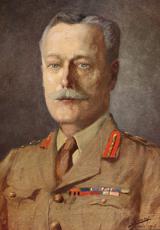The battle of the Somme

The aim of the allied offensive on the Somme was to break down the German front in Picardy. Between July and November 1916 fighting involved soldiers of around twenty nationalities. Taking into account all the warring parties, this battle was responsible for 1,200,000 dead, injured and missing. The Somme is therefore a place of remembrance for many nations.
Planned by the Allies from December 1915, the battle of the Somme began on the 14th July 1916. Intense preparation of artillery had started on the 24th June and 1.5 million shells were to be discharged along a 25 km front. Just like the battle of Verdun, which had begun in February 1916, the prolonged fighting between July and November 1916 created a new kind of war, where ”battles” had neither an end nor a discernable result. It amounted to a series of operations in preparation for a battle that, in fact, never took place. The confrontation on the Somme saw operations staggered over 5 months, prolonged by sporadic fighting and, after November 1916, lacking in strategy.
Since the German invasion of the summer of 1914, the border province of Picardy constituted a flexible 20 km wide strategic strip and a complex battle zone. On the allied side, at the junction of the British and French armies, this militarised zone served a series of first and second lines, in front of deeper defences, rest areas, followed by the towns and villages to the rear of the front. Since 1914, the front had varied. It had gone from the west of Doullens and Amiens in September 1914 (when a large part of the Picardy area was in German hands) to being under limited and stabilised enemy control in 1915 to the north east of the Oise (including Noyon), to the east of the Somme with Péronne and to the north west of the Aisne. Where the 4th British Army and the 6th French Army converged, the objective of the allied offensive on the Somme was therefore to breach the German front in Picardy, in order to take possession of the enemy communications hub to the north of Saint-Quentin, in the Valenciennes-Maubeuge-Cambrai triangle. The aim was to cause the Germans to retreat along the western front, by concentrating British effort on the front. This had been shortened following the German offensive on Verdun, which was mostly borne by the French armies. In 1916, it was a question of whether it would be possible to bring about the strategic unblocking along the western front by breaking down the enemy's defensive positions through a series of successive siege operations carried out mid- campaign. Taking advantage of the terrain and co-ordinated as a network, the spectacular concealed fortifications of the Germans had led to the ”besiegers” setting up a real siege infrastructure since December 1915. There were networks of narrow trenches to facilitate liaison between units about attacks, blast chambers to destroy defensive positions by using underground explosions, logistical planning in place to transport units and equipment, involving eight new railway tracks and 80,000 km of cabling in the British sector to allow 30 trains per day and 1,500 British artillery guns. The preparation for this battle was staggered over six months.
When the ”battle” was launched on the 1st July, the Allies never imagined that the Germans would be able to gradually create new lines of defence that would be able to resist successive attacks on their defensive positions for five months. After a British military disaster without precedent at the end of the initial clash on 1st July, several successive waves of attacks were to gradually gain ground. Between the 2nd and 13th July, they targeted the second German position, which was taken on the 14th. However, the Germans had been able to set up their 3rd, which was gradually eroded by a burst of attacks up until September.
On the 15th September 1916 the ”second battle of the Somme” started, marked by the first deployment of the Great War's British Mark I tank, which was both disappointing and without major tactical success (50% loss in September 1916). The 3rd German line was attacked and taken on the 25th September, even though the 4th German line was in operation and awaiting two other lines that were in the process of being built. The Allies managed to take the 4th line seven times between the 7th October and the end of November.Bad weather during the autumn was then to suspend their operations. The battle ceased at the end of November, after allied attacks had broken through a series of enemy defences. These operations were marked by human losses without precedent, but on a scale of those of Verdun. Taking into account all the warring parties, there was a total of 1,200,000 dead, injured and missing, including 500,000 British, 200,000 French and 500,000 Germans. These losses were compounded through the heavy rotation of units, as 1.5 million Germans and 2.5 million British and French succeeded each other in five months in the Somme.
The intensity of firing gave crushing superiority to the defensive over the offensive. But above all, it prevented movement and neutralised the battle. Extensive use of artillery and machine guns limited the mobility of units. It was a determining factor in the tactical planning of attacks, as well as for the static defences that were reconstructed along new German lines. This war of weaponry demonstrated the need for industrial mobilisation, a lesson learned in November by Hindenburg and Ludendorf in the German General High Command. The violence of the destruction by artillery on the ground was the main obstacle to moving artillery further forward in support of any in-depth breach of the infantry, as demonstrated by operations carried out in the first fortnight of July. With any deep penetration and movement impossible, in the words of S. Audoin-Rouzeau and G. Krumeich ”the battle was dying from its own violence”. Although artillery preparation and the firing of mortars was able to weaken positions, they could totally destroy neither the concealed positions nor the networks of barbed wire, and neither could the detonation of mines at places like La Boisselle, near Pozières in the central sector, as was tragically demonstrated in the initial British attack on 1st July. For the British armies, it was carnage. Out of the 320,000 soldiers engaged, the attack accounted for 60,000 losses in one day, including 20,000 dead, compared with 6,000 for the Germans.
The extent of the disaster was not immediately known because the general staff and the allied press still remained optimistic. In 1916 the Somme, like the battle of Verdun, resulted in an increase in censorship and propaganda - in reality a deliberate shaping of public opinion. The image portrayed in film and photographs is the work of official large-scale propaganda, as much on the part of the allies as the Germans, to satisfy the keen demand for information from behind the front. Public opinion, both British and German, quickly relied too much on the national representation of this ”battle”.
The Somme thus became a tremendous battle of images, which saw the British command establish unheard of media coverage of operations. By sending journalists close to the front line, the British general staff wanted to provide an official image of the fighting, which was heavily edited, according to Beach Thomas, who covered the events for the Daily Mail. Hundreds of official photographs were sent back every month. And on the 21st April 1916 the film The Battle of the Somme came out, which was seen at the cinema by 20 million British people in three months. The demand for realistic information, or what was believed to be such away from the front lines, makes it possible to talk about a turning point in war propaganda in the 20th Century through the use of images. And this fact would have been of no importance had the battle of the Somme not pitted about twenty nations from many empires against each other, as the profusion of commemorative monuments, military cemeteries and places of combat still preserved today on Picardy soil bear witness, such as Thiepval for the British and the Beaumont Hamel section of trenches.
There are, however, some very differing experiences of war in the mixed views given by the various French, British and German contingents engaged on the Somme. A defensive war for the British, the battle of the Somme was partly responsible for defining the national identity of some of the dependencies of the British Empire, such as Australians, New Zealanders, South Africans and, to a lesser degree, Canadians. Above all, these nations wanted their independence and they wanted it quickly, as a reward for their participation in a war that had equally been fought for the empire. The Somme was to strengthen British patriotism.
Enlisting voluntarily, many of the ”friends” who left for the war in the expeditionary corps came from the same British towns or villages: more than 5,000 Londoners were injured and killed, 3,500 from Manchester, and many from mining communities, to the point where the sacrifices of the Somme had raised awareness and radicalised British public opinion, intent on waging all-out war after the summer of 1916. It was an advanced war to defend national territory through patriotic over-investment on the German side; ”Watch over the Somme” was on the mind rather than the traditional ”Watch over the Rhine” (Wacht am Rhein). The German conscience sought to contest the image of barbarity of German troops created by allied propaganda to remind people of German atrocities committed against civil populations during the invasion of 1914. So they got hold of examples of British destruction of French villages in order to turn the accusation around for the sake of German public opinion and to defend their soldiers. The German soldier was thus seen as justified in defending his homeland along an advanced line, admittedly in enemy territory, but full of significance in terms of defending his nation. Then along came the war literature of the 1920's to feed the common myth of the Frontkamerad, born in the Somme in 1916. Paradoxically, from 1916 onwards the French had put the fighting in the Somme slightly to the back of the national consciousness, as their own patriotic contribution had been accorded to Verdun in the spring. It was to come into play later, in the spring of 1917 and during the German offensive of March 1918 in the Somme, in a defensive representation of land, villages and the country. It is not as memorable as that attributed by British and German writers, such as the poet Ted Hughes or Ernst Jünger in The Storm of Steel. The Somme thus embodied a sort of ”Verdun” for those warring parties who were not French. With the Picardy front, it had played a part in providing a real sense of the war for a generation of soldiers and civilians who had experienced it. The Somme was not just a military shock; in 1916 it was the culture shock of the Great War. It remained a national place of remembrance for many nations in the 20th century.
Source: Olivier Forcade, University of Picardy; Stéphane Audoin-Rouzeau, Jean-Jacques Becker (ed.), Encyclopaedia of the Great War, Bayard, 2004, 1 343 p.; Anne Duménil, Philippe Nivet (ed.), Picardy, , Amiens, Encrage, 1998, 220 p.; John Keegan, Anatomy of the battle.
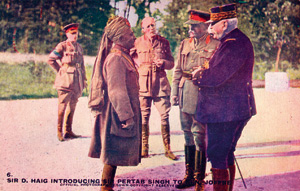
Douglas Haig présente Pertab Singh au général Joffre. Source : SHD
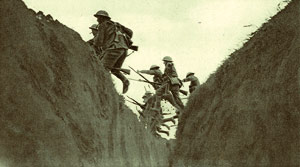
L'infanterie britannique à l'assaut, 1916. Source : SHD
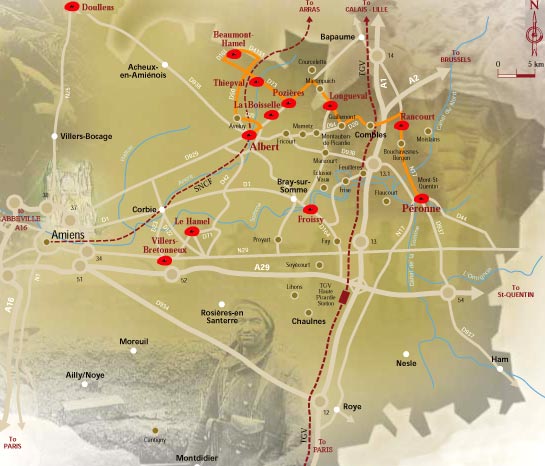
Carte des champs de bataille de la Somme. Source : Comité du tourisme de la Somme
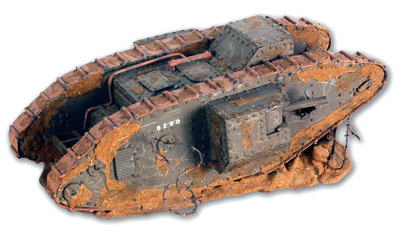
Modèle réduit de tank Mark 1. Source : Historial de la Grande Guerre
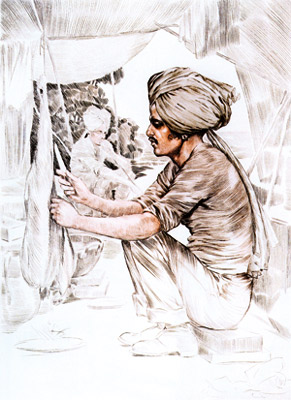
Sihk du Penjab. Source : MINDEF/SGA/DMPA
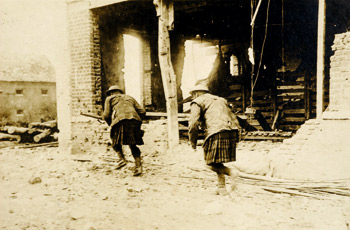
Soldats écossais en embuscade, front de l'Aisne. Source : Historial de la Grande Guerre
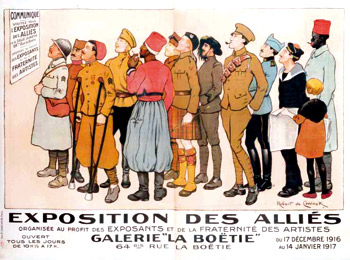
Affiche. Source : Historial de la Grande Guerre



